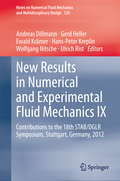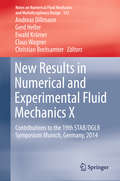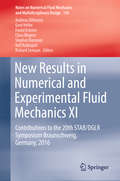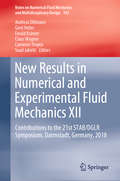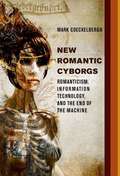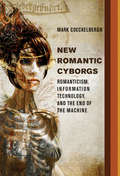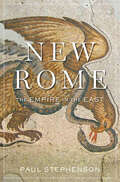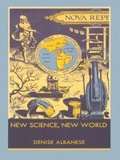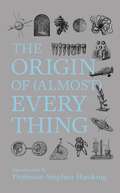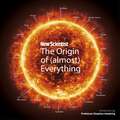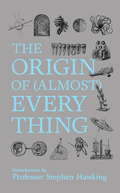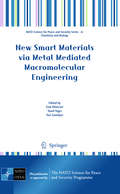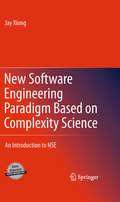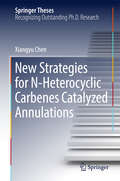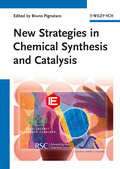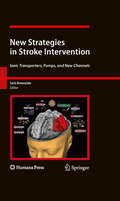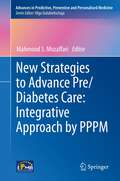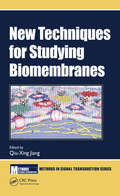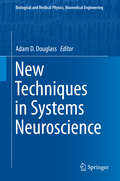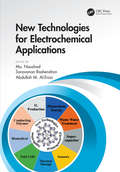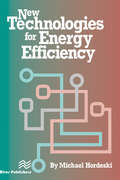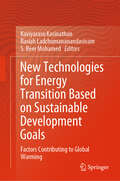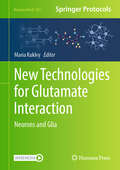- Table View
- List View
New Results in Numerical and Experimental Fluid Mechanics IX
by Andreas Dillmann Gerd Heller Ewald Krämer Hans-Peter Kreplin Wolfgang Nitsche Ulrich RistThis book presents contributions to the 18th biannual symposium of the German Aerospace Aerodynamics Association (STAB). The individual chapters reflect ongoing research conducted by the STAB members in the field of numerical and experimental fluid mechanics and aerodynamics, mainly for (but not limited to) aerospace applications, and cover both nationally and EC-funded projects. By addressing a number of essential research subjects, together with their related physical and mathematics fundamentals, the book provides readers with a comprehensive overview of the current research work in the field, as well as its main challenges and new directions. Current work on e. g. high aspect-ratio and low aspect-ratio wings, bluff bodies, laminar flow control and transition, active flow control, hypersonic flows, aeroelasticity, aeroacoustics and biofluid mechanics is exhaustively discussed here.
New Results in Numerical and Experimental Fluid Mechanics X
by Andreas Dillmann Gerd Heller Ewald Krämer Claus Wagner Christian BreitsamterThis book presents contributions tothe 19th biannual symposium of the German Aerospace Aerodynamics Association(STAB) and the German Society for Aeronautics and Astronautics (DGLR). Theindividual chapters reflect ongoing research conducted by the STAB members inthe field of numerical and experimental fluid mechanics and aerodynamics,mainly for (but not limited to) aerospace applications, and cover bothnationally and EC-funded projects. Special emphasis is given to collaborativeresearch projects conducted by German scientists and engineers fromuniversities, research-establishments and industries. By addressing a number ofcutting-edge applications, together with the relevant physical and mathematicsfundamentals, the book provides readers with a comprehensive overview of thecurrent research work in the field. Though the book's primary emphasis is onthe aerospace context, it also addresses further important applications, e. g. in ground transportation and energy.
New Results in Numerical and Experimental Fluid Mechanics XI
by Andreas Dillmann Gerd Heller Ewald Krämer Claus Wagner Stephan Bansmer Rolf Radespiel Richard SemaanThis book gathers contributions to the 20th biannual symposium of the German Aerospace Aerodynamics Association (STAB) and the German Society for Aeronautics and Astronautics (DGLR). The individual chapters reflect ongoing research conducted by the STAB members in the field of numerical and experimental fluid mechanics and aerodynamics, mainly for (but not limited to) aerospace applications, and cover both nationally and EC-funded projects. Special emphasis is given to collaborative research projects conducted by German scientists and engineers from universities, research-establishments and industries. By addressing a number of cutting-edge applications, together with the relevant physical and mathematics fundamentals, the book provides readers with a comprehensive overview of the current research work in the field. Though the book's primary emphasis is on the aerospace context, it also addresses further important applications, e. g. in ground transportation and energy.
New Results in Numerical and Experimental Fluid Mechanics XII: Contributions to the 21st STAB/DGLR Symposium, Darmstadt, Germany, 2018 (Notes on Numerical Fluid Mechanics and Multidisciplinary Design #142)
by Cameron Tropea Andreas Dillmann Gerd Heller Ewald Krämer Claus Wagner Suad JakirlićThis book gathers contributions to the 21st biannual symposium of the German Aerospace Aerodynamics Association (STAB) and the German Society for Aeronautics and Astronautics (DGLR). The individual chapters reflect ongoing research conducted by the STAB members in the field of numerical and experimental fluid mechanics and aerodynamics, mainly for (but not limited to) aerospace applications, and cover both nationally and EC-funded projects. Special emphasis is given to collaborative research projects conducted by German scientists and engineers from universities, research-establishments and industries. By addressing a number of cutting-edge applications, together with the relevant physical and mathematics fundamentals, the book provides readers with a comprehensive overview of the current research work in the field. The book’s primary emphasis is on aerodynamic research in aeronautics and astronautics, and in ground transportation and energy as well.
New Results in Numerical and Experimental Fluid Mechanics XIII: Contributions to the 22nd STAB/DGLR Symposium (Notes on Numerical Fluid Mechanics and Multidisciplinary Design #151)
by Andreas Dillmann Gerd Heller Ewald Krämer Claus WagnerThis book offers timely insights into research on numerical and experimental fluid mechanics and aerodynamics, mainly for (but not limited to) aerospace applications. It reports on findings by members of the STAB (German Aerospace Aerodynamics Association) and DGLR (German Society for Aeronautics and Astronautics) and covers both nationally and EC-funded projects. Continuing on the tradition of the previous volumes, the book highlights innovative solutions, promoting translation from fundamental research to industrial applications. It addresses academics and professionals in the field of aeronautics, astronautics, ground transportation, and energy alike.
New Results in Numerical and Experimental Fluid Mechanics XIV: Contributions to the 23rd STAB/DGLR Symposium, Berlin, Germany, 2022 (Notes on Numerical Fluid Mechanics and Multidisciplinary Design #154)
by Andreas Dillmann Gerd Heller Ewald Krämer Claus Wagner Julien WeissThis book offers timely insights into research on numerical and experimental fluid mechanics and aerodynamics, mainly for (but not limited to) aerospace applications. It reports on findings by members of the Deutsche Strömungsmechanische Arbeitsgemeinschaft, STAB (German Aerodynamics/Fluid Mechanics Association) and the Deutsche Gesellschaft für Luft- und Raumfahrt - Lilienthal Oberth e.V., DGLR (German Society for Aeronautics and Astronautics) and covers both nationally and EC-funded projects. Continuing on the tradition of the previous volumes, the book highlights innovative solutions, promoting translation from fundamental research to industrial applications. It addresses academics and professionals in the field of aeronautics, astronautics, ground transportation, and energy alike.
New Romantic Cyborgs: Romanticism, Information Technology, and the End of the Machine
by Mark CoeckelberghRomanticism and technology are widely assumed to be opposed to each other. Romanticism -- understood as a reaction against rationalism and objectivity -- is perhaps the last thing users and developers of information and communication technology (ICT) think about when they engage with computer programs and electronic devices. And yet, as Mark Coeckelbergh argues in this book, this way of thinking about technology is itself shaped by romanticism and obscures a better and deeper understanding of our relationship to technology. Coeckelbergh describes the complex relationship between technology and romanticism that links nineteenth-century monsters, automata, and mesmerism with twenty-first-century technology's magic devices and romantic cyborgs.Coeckelbergh argues that current uses of ICT can be interpreted as attempting a marriage of Enlightenment rationalism and romanticism. He describes the "romantic dialectic," when this new kind of material romanticism, particularly in the form of the cyborg as romantic figure, seems to turn into its opposite. He shows that both material romanticism and the objections to it are still part of modern thinking, and part of the romantic dialectic. Reflecting on what he calls "the end of the machine," Coeckelbergh argues that to achieve a more profound critique of contemporary technologies and culture, we need to explore not only different ways of thinking but also different technologies -- and that to accomplish the former we require the latter.
New Romantic Cyborgs: Romanticism, Information Technology, and the End of the Machine (The\mit Press Ser.)
by Mark CoeckelberghAn account of the complex relationship between technology and romanticism that links nineteenth-century monsters, automata, and mesmerism with twenty-first-century technology's magic devices and romantic cyborgs.Romanticism and technology are widely assumed to be opposed to each other. Romanticism—understood as a reaction against rationalism and objectivity—is perhaps the last thing users and developers of information and communication technology (ICT) think about when they engage with computer programs and electronic devices. And yet, as Mark Coeckelbergh argues in this book, this way of thinking about technology is itself shaped by romanticism and obscures a better and deeper understanding of our relationship to technology. Coeckelbergh describes the complex relationship between technology and romanticism that links nineteenth-century monsters, automata, and mesmerism with twenty-first-century technology's magic devices and romantic cyborgs.Coeckelbergh argues that current uses of ICT can be interpreted as attempting a marriage of Enlightenment rationalism and romanticism. He describes the “romantic dialectic,” when this new kind of material romanticism, particularly in the form of the cyborg as romantic figure, seems to turn into its opposite. He shows that both material romanticism and the objections to it are still part of modern thinking, and part of the romantic dialectic. Reflecting on what he calls “the end of the machine,” Coeckelbergh argues that to achieve a more profound critique of contemporary technologies and culture, we need to explore not only different ways of thinking but also different technologies—and that to accomplish the former we require the latter.
New Rome: The Empire in the East (History Of The Ancient World Ser. #6)
by Paul StephensonA comprehensive new history of the Eastern Roman Empire based on the science of the human past. As modern empires rise and fall, ancient Rome becomes ever more significant. We yearn for Rome’s power but fear Rome’s ruin—will we turn out like the Romans, we wonder, or can we escape their fate? That question has obsessed centuries of historians and leaders, who have explored diverse political, religious, and economic forces to explain Roman decline. Yet the decisive factor remains elusive. In New Rome, Paul Stephenson looks beyond traditional texts and well-known artifacts to offer a novel, scientifically minded interpretation of antiquity’s end. It turns out that the descent of Rome is inscribed not only in parchments but also in ice cores and DNA. From these and other sources, we learn that pollution and pandemics influenced the fate of Constantinople and the Eastern Roman Empire. During its final five centuries, the empire in the east survived devastation by natural disasters, the degradation of the human environment, and pathogens previously unknown to the empire’s densely populated, unsanitary cities. Despite the Plague of Justinian, regular “barbarian” invasions, a war with Persia, and the rise of Islam, the empire endured as a political entity. However, Greco-Roman civilization, a world of interconnected cities that had shared a common material culture for a millennium, did not. Politics, war, and religious strife drove the transformation of Eastern Rome, but they do not tell the whole story. Braiding the political history of the empire together with its urban, material, environmental, and epidemiological history, New Rome offers the most comprehensive explanation to date of the Eastern Empire’s transformation into Byzantium.
New Science, New World
by Denise AlbaneseIn New Science, New World Denise Albanese examines the discursive interconnections between two practices that emerged in the seventeenth century--modern science and colonialism. Drawing on the discourse analysis of Foucault, the ideology-critique of Marxist cultural studies, and de Certeau's assertion that the modern world produces itself through alterity, she argues that the beginnings of colonialism are intertwined in complex fashion with the ways in which the literary became the exotic "other" and undervalued opposite of the scientific.Albanese reads the inaugurators of the scientific revolution against the canonical authors of early modern literature, discussing Galileo's Dialogue on the Two Chief World Systems and Bacon's New Atlantis as well as Milton's Paradise Lost and Shakespeare's The Tempest. She examines how the newness or "novelty" of investigating nature is expressed through representations of the New World, including the native, the feminine, the body, and the heavens. "New" is therefore shown to be a double sign, referring both to the excitement associated with a knowledge oriented away from past practices, and to the oppression and domination typical of the colonialist enterprise. Exploring the connections between the New World and the New Science, and the simultaneously emerging patterns of thought and forms of writing characteristic of modernity, Albanese insists that science is at its inception a form of power-knowledge, and that the modern and postmodern division of "Two Cultures," the literary and the scientific, has its antecedents in the early modern world.New Science, New World makes an important contribution to feminist, new historicist, and cultural materialist debates about the extent to which the culture of seventeenth-century England is proto-modern. It will offer scholars and students from a wide range of fields a new critical model for historical practice.
New Scientist (almost) Everything: The Origin Of (almost) Everything
by Stephen Hawking New Scientist Graham Lawton Jennifer DanielFrom what actually happened in the Big Bang to the accidental discovery of post-it notes, the history of science is packed with surprising discoveries. Did you know, for instance, that if you were to get too close to a black hole it would suck you up like a noodle (it's called spaghettification), why your keyboard is laid out in QWERTY (it's not to make it easier to type) or why animals never evolved wheels? New Scientist does.And now they and award-winning illustrator Jennifer Daniel want to take you on a colorful, whistle-stop journey from the start of our universe (through the history of stars, galaxies, meteorites, the Moon and dark energy) to our planet (through oceans and weather and oil) and life (through dinosaurs to emotions and sex) to civilization (from cities to alcohol and cooking), knowledge (from alphabets to alchemy) ending up with technology (computers to rocket science). Witty essays explore the concepts alongside enlightening infographics that zoom from how many people have ever lived, to showing you how a left-wing brain differs from a right-wing one...
New Scientist (almost) Everything: from the Big Bang to Belly-button Fluff
by Stephen Hawking Graham Lawton New ScientistDOES ANYTHING EAT WASPS meets INFORMATION IS BEAUTIFUL: A journey through life, the universe and everything. From what actually happened in the Big Bang to the accidental discovery of post-it notes, science is packed with surprising discoveries. Did you know, for instance, that if you were to get too close to a black hole it would suck you up like a noodle (it's called spaghettification), why your keyboard is laid out in QWERTY (it's not to make it easier to type) or whether the invention of the wheel was less important to civilisation than the bag (think about it). New Scientist does. And now they and illustrator Jennifer Daniel want to take you on a whistlestop journey from the start of our universe (through the history of stars, galaxies, meteorites, the Moon and dark energy) to our planet (through oceans and weather to oil) and life (through dinosaurs to emotions and sex) to civilisation (from cities to alcohol and cooking), knowledge (from alphabets to alchemy) ending up with technology (computers to rocket science). Witty essays explore the concepts alongside enlightening infographics that zoom from how many people have ever lived to showing you how a left-wing brain differs from a right-wing one.(P)2017 John Murray Press
New Scientist: The Origin of (almost) Everything
by Stephen Hawking Graham Lawton New ScientistIntroduction by Professor Stephen Hawking.When Edwin Hubble looked into his telescope in the 1920s, he was shocked to find that nearly all of the galaxies he could see through it were flying away from one another. If these galaxies had always been travelling, he reasoned, then they must, at some point, have been on top of one another. This discovery transformed the debate about one of the most fundamental questions of human existence - how did the universe begin?Every society has stories about the origin of the cosmos and its inhabitants, but now, with the power to peer into the early universe and deploy the knowledge gleaned from archaeology, geology, evolutionary biology and cosmology, we are closer than ever to understanding where it all came from. In The Origin of (almost) Everything, New Scientist explores the modern origin stories of everything from the Big Bang, meteorites and dark energy, to dinosaurs, civilisation, timekeeping, belly-button fluff and beyond.From how complex life evolved on Earth, to the first written language, to how humans conquered space, The Origin of (almost) Everything offers a unique history of the past, present and future of our universe.
New Smart Materials via Metal Mediated Macromolecular Engineering
by Ezat Khosravi Yuri Savelyev Yusuf YagciControl over macromolecular architecture and resulting material properties has been a central goal of polymer chemistry. There has been much interest in developing new synthetic routes to prepare smart materials with novel compositions and topologies for various applications. The considerable progress in the metal mediated macromolecular engineering over the past decade has had a major impact on the development of well-defined macromolecular architectures and the synthesis of smart materials. Particularly, remarkable strong developments have been observed for the synthesis of smart materials via four metal mediated macromolecular engineering techniques; Anionic, ROMP, ATRP and Click Chemistry. These materials have found uses in advanced microelectronics, technical and biomedical applications as well as in chemical sensors applications. This book is comprised of 27 chapters written by leading scientists from NATO and Partner Countries who have greatly contributed in the area of Anionic, ROMP, ATRP and Click Chemistry. It highlights the fundamental aspects and recent developments of these four powerful techniques and evaluate their potential in the syntheses of smart materials from complex structures (grafts, brushes, dendrimers, etc.) to nanostructures (self-assembly, nano-size, etc) for a wide range of applications. The book reports on the synthesis of a wide range of well-defined complex polymeric systems such as thermoresponsive smart polymers, star copolymers, biocompatible polymers, amphipilic smart nano structured, conducting polymers, self assembled polymers, and hyperbranced polymers.
New Software Engineering Paradigm Based on Complexity Science
by Jay XiongThis book describes a complete revolution in software engineering based on complexity science through the establishment of NSE - Nonlinear Software Engineering paradigm which complies with the essential principles of complexity science, including the Nonlinearity principle, the Holism principle, the Complexity Arises From Simple Rules principle, the Initial Condition Sensitivity principle, the Sensitivity to Change principle, the Dynamics principle, the Openness principle, the Self-organization principle, and the Self-adaptation principle. The aims of this book are to offer revolutionary solutions to solve the critical problems existing with the old-established software engineering paradigm based on linear thinking and simplistic science complied with the superposition principle, and make it possible tohelp software development organizations double their productivity, halve their cost, and remove 99% to 99.99% of the defects in their software products, and efficiently handle software complexity, conformity, visibility, and changeability. It covers almost all areas in software engineering. The tools NSE_CLICK- an automatic acceptance testing platform for outsourcing (or internally developed) C/C++ products, and NSE_CLICK_J - an automatic acceptance testing platform for outsourcing (or internally developed) Java products are particularly designed for non-technical readers to view/review how the acceptance testing of a software product developed with NSE can be performed automatically, and how the product developed with NSE is truly maintainable at the customer site.
New Strategies for N-Heterocyclic Carbenes Catalyzed Annulations
by Xiangyu ChenThis thesis focuses on NHC-catalyzed annulation of nitroalkenes, enals and α,β-unsaturated carboxylic acids. (1) NHCs were found to be efficient catalysts for the [4+2] annulation of β-substituted nitroalkenes. The scope of Rauhut-Currier reaction was successfully extended to the most challenging β-substituted alkenes by this method; (2) Enals were successfully used for [4+2] annulations with azodicarboxylates catalyzed by NHC via γ-addition. Highly enantiopure tetrahydropyridazinones and γ-amino acid derivatives could be easily prepared by subsequent transformations of the resulting dihydropyridazinones. (4) The readily available α,β-unsaturated carboxylic acids were first successfully employed to generate the α,β-unsaturated acyl azolium intermediates by using NHC for the enantioselective [3+2] and [3+3] annulations.
New Strategies in Chemical Synthesis and Catalysis
by Bruno PignataroThis volume represents one of the two edited by inviting a selection of young researchers participating to the European Young ChemistAward 2010. The other volume concerns the area of Nanotechnology/Material Science and is titled: Molecules at Work.This book contains the contributions of selected young chemists from the field of synthetic chemistry. The contributions are groupedunder the three following umbrella topics:Synthetic MethodsCatalysisCombinatorial and Chemical BiologyThis volume is an indispensable read for all organic and inorganic chemists, biochemists, chemists working with/on organometallics,and Ph.D. students in chemistry interested in seeing what tomorrow's chemistry will look like.
New Strategies in Stroke Intervention
by Lucio AnnunziatoIschemic brain damage represents a major source of morbidity and mortality in westernized society and poses a significant financial burden on the health care system. To date, few effective therapies have been realized. Recent evidence, however, suggests that channels, pumps, and ionic exchangers are involved in CNS ischemia and ischemic stroke, but the potential contribution of these channels for curing stroke is far less understood than for many other normal and pathological conditions. New Strategies in Stroke Intervention: Ionic Channels, Pumps, and Transporters, analyzes the roles played by targets in stroke development and the potential action of drugs modulating these proteins. This book provides a groundbreaking review of these ionic channels, pumps, and transporters as regulators of neuronal ionic homeostasis, providing a better understanding of ischemic brain disorders and the new pharmacological avenues for a cure.
New Strategies to Advance Pre/Diabetes Care: Integrative Approach by PPPM
by Mahmood S. MozaffariThis book is intended to provide up-to-date and emerging information in the field of diabetes mellitus with a focus on preventive, predictive and personalized medicine.
New Techniques for Studying Biomembranes (Methods in Signal Transduction Series)
by Qiu-Xing JiangNew Techniques for Studying Biomembranes describes some of the latest methods used to investigate the dynamic distribution of specific lipids in membranes and their effects on other membrane components. The contributors present important discoveries with respect to lipid analysis and lipid interactions with membrane proteins. Various methods, which have been used to study lipid bilayer structure and lipid organization in membranes, include both in vitro and in vivo membrane systems, and study membrane proteins in various membrane systems. Key Features: Reviews both in vivo and in vitro analytical technologies and methods for studying membrane structure and function Explores how lipid bilayers and membrane proteins interact Includes contributions from an international team of researchers actively studying membrane structure and function Identifies various diseases whose causes are related to membrane proteins Related Titles: Christopher R. Jacobs, Hayden Huang, and Ronald Y. Kwon. Introduction to Cell Mechanics and Mechanobiology (ISBN 978-0-8153-4425-4) Wendell Lim and Bruce Mayer. Cell Signaling: Principles and Mechanisms (ISBN 978-0-8153-4244-1) Stephen Rothman. Proteins Crossing Membranes: A Scientist’s Memoir (978-0-3670-7449-4)
New Techniques in Systems Neuroscience
by Adam D. DouglassThis volume is essential reading for anyone wishing to understand the recent explosion of experimental tools in neuroscience that now make it possible to manipulate, record, and understand neuronal activity within the intact brain, and which are helping us learn how the many neurons that comprise a network act together to control behavior. Leaders in the field discuss the latest developments in optogenetics, functional imaging, circuit mapping, and the application of these tools to complex biological problems.
New Technologies for Electrochemical Applications
by Mu. Naushad Saravanan Rajendran Abdullah M. Al-EniziThe field of electrochemistry is exploring beyond its basic principles to innovation. New Technologies for Electrochemical Applications presents advancements in electrochemical processes, materials, and technology for electrochemical power sources such as batteries, supercapacitors, fuel cells, hydrogen storage and solar cells. It also examines various environmental applications such as photo electrochemistry, photosynthesis, and coating. Organized to give readers an overview of the current field in electrochemical applications, this book features a historical timeline of advancements and chapters devoted to the topics of organic material and conducting polymers for electrochemical purposes. Established experts in the field detail state-of-the-art materials in biosensors, immunosensors, and electrochemical DNA. This edited reference is a valuable resource for graduate and post-graduate students, and researchers in disciplines such as chemistry, physics, electrical engineering and materials science.
New Technologies for Energy Efficiency
by Michael Frank HordeskiFirst published in 2002. This book examines the full scope of technologies available to address the electricity supply crisis. The author details the tools and technologies available for incorporating smaller, cleaner, more efficient energy into energy management plans. He examines the role of new technologies in reducing operating costs and developing more innovative and practical approaches to energy management. Topics include implementation of alternative energy programs, management of power quality, cost-effective power generation solutions, cost-effective energy services, information monitoring and diagnostic systems, energy storage options, integration of lighting and cooling systems, and more.
New Technologies for Energy Transition Based on Sustainable Development Goals: Factors Contributing to Global Warming
by Kaviyarasu Kasinathan Rasiah Ladchumananandasivam S. Beer MohamedThis book describes numerous issues and brings an improved understanding of a key agenda item for the sustainable development goals (SDGs). The SDGs represent an urgent call for action by all countries, developed and developing, working jointly within the global community. A few of the industries it supports include food processing, energy, biomedical science, space research, drug delivery, and biosensors. This book highlights multidisciplinary solutions for protecting the environment while ensuring the future of our planet. The book mainly targets undergraduates, postgraduates, and doctoral students who are working in materials science and researchers across the world working in interdisciplinary research for climate change for sustainable growth.
New Technologies for Glutamate Interaction: Neurons and Glia (Neuromethods #2780)
by Maria KukleyThis volume explores the latest technologies used to study the co-existence of neuronal and neuron-glia synapses in the brain. The chapters in this volume are organized into three parts. Part One covers recent advancements in the technical approaches for studying glutamatergic signalling between neurons. Part Two highlights approaches to study the functional role of astrocytes at neuronal synapses. Part Three focuses on fast signalling at neuron-glia synapses, and highlights relevant methods for investigating these unusual synapses, including slice electrophysiology and in vivo gene delivery techniques. In the Neuromethods series style, all chapters contain key advices from experts in the field that are valuable for performing successful experiments on the topic in your laboratory.Cutting-edge and thorough, New Technologies for Glutamate Interactions: Neurons and Glia is a valuable resource for both neuronal and glial physiologists who are interested in learning about and developing new methods to further understand neuronal and neuron-glia synaptic transmission.
